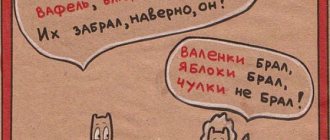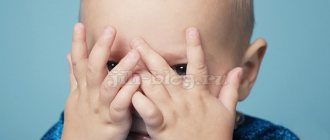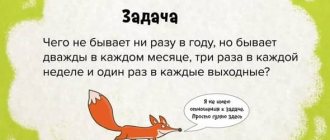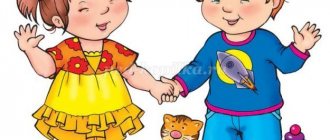Finger game “Autumn” in the younger group
The fingers went out for a walk - the children made walking movements with their fingers on a horizontal surface;
To collect leaves. - make raking and grasping movements with the hands;
Yellow leaf and red leaf,
Let's count them quickly. - clap their hands;
How many leaves did you collect in the bouquet?
One, and two, and three, four. - count by bending your fingers from the index finger to the little finger;
That's how many leaves we got! — raise their arms above their heads, rotate their hands left and right.
Finger gymnastics “Wild Animals” in the middle group
We offer finger games to improve motor skills and muscle strength of fingers and hands in preschoolers of the middle age group.
Squirrel
A squirrel jumps through the pine trees; the students quickly move their fingers along the horizontal surface;
He deftly tears and hides the pine cones—they clench and open their right and left fists asynchronously;
Looks for seeds in the grass, rubs his hands together;
And keeps it in his hollow. - fold the brushes in a cup shape.
Friendship
Animals are true friends: - children connect their hands with a vertical “boat”;
The beaver has a friend in the river; they tap their little fingers against each other;
The hedgehog has a friend, they tap on the nameless ones;
The gray bunny has middle fingers;
Friendship is made by wild boars - with index fingers;
Even the ants are friends. - tapping their thumbs together;
They play, have fun, rotate their hands left and right;
Friends are frolicking in the forest. - they shake their brushes as if they are shaking something off them.
Who lives in the forest?
There is a large family in the forest: - children spread their fingers on raised hands, depicting a forest;
The hedgehog digs a hole under the stump; bend the right little finger with the left index finger;
A fox lives under a pine tree, - bend the right nameless one;
Behind the hill is the elk's dwelling, - right middle;
A little bunny sits under a bush - right index;
And an owlet lives in a hollow. - bend the right thumb with the left index finger;
All the animals were counted
We learned about their houses. - quickly clench and open your fists.
Chanterelle
Beautiful fox
He boasts about beauty: - students rub one palm against the other;
With a fluffy tail,
Golden fur coat. - spreading their fingers, stroke them on one hand, then on the other;
It darts around the bushes, “running” with its index and middle fingers along a horizontal surface;
He scatters the bunnies. - asynchronously strike with fists on a flat surface.
Squirrel and sparrow
The squirrel, looking out from the hollow, the pupils fold their right and left fingers into whispers, then combine them, while raising their index fingers;
I saw a sparrow: - fold the open hands in a cross shape, hook one thumb behind the other - you get bird wings, which they flap;
Fly into the hollow quickly
It's calmer and warmer here. - fold the hands into balls.
Game "Centipede" for younger preschoolers
A centipede is walking along an autumn path. - children move in one place with marching steps;
Suddenly drops began to fall from the sky. - tap their fingers on the open palm of the other hand;
Oh, forty paws will get wet!
I don’t want a cold, I’ll go around the puddles in an instant,” they make a small circle, imitating going around a puddle;
I won’t bring dirt home, I’ll shake it off all my paws.
And I stomp into the hole, and I stomp loudly. — they walk in place, raising their legs high, knocking them on the floor.
Finger gymnastics “Fingers in the forest”
Mishutka invites us to visit her. The fingers go with us.
| One, two, three, four, five, the fingers went out for a walk. This finger found a mushroom, This finger began to clean, This one cut, This one ate, Well, this one watched everything. | In accordance with the text, alternately unclench your fingers clenched into a fist. Clench your fingers into a fist and unclench them. In accordance with the text, straighten your fingers one by one. |
5. Task “Find the path to the house” (on a form)
Draw a path to Mishutka's house. You need to find the right path so as not to end up in a swamp or with Baba Yaga.
6. Task “In the forest” (on a form)
Let's color the picture as Mishutka tells us:
Color in the animals that are drawn below. Color the wide stream blue, the narrow stream blue. The tree that is higher is dark green, the lower one is light green. A fox and a little fox are drawn to the right of the stream, and a mother bear and a bear cub are drawn to the left. Draw a fungus on the right, a flower on the left.
7. Task “Find the extra object” (using cards)
So, we got to the hut, in which there are many different objects. Mishutka hands out cards to the children.
Find the extra item on the card. Explain your choice, name the remaining items in one word.
Stage IV. reflective
Summing up, reflection, farewell ritual “Flower of Fairy Tales”
Lesson 26
Topic: Fairy tale "Turnip". Friendship, mutual assistance.
Goals:
- promote the moral development of children by developing their ideas about friendship and mutual assistance;
- create the moral foundations of the child’s personality;
- development of cognitive mental processes.
Materials: magic flower, cut-out picture for the fairy tale “Turnip”, fairy tale characters for display, task “Who is Lost”, forms with tasks, simple and colored pencils.
Plan:
Stage I. Organizational
Greeting "Magic Flower"
Stage II. Motivational
The petal took us into a fairy tale. What fairy tale have we found ourselves in?
Quest “Fairy Tale Fragment”
The psychologist shows the children a piece from a cut-out picture based on the fairy tale “Turnip”.
Look carefully and guess which fairy tale this fragment is from.
2. Fairy tale “Turnip”»
The psychologist tells and shows the children a fairy tale.
Grandfather planted a turnip and it grew big, very big. The grandfather began to pull the turnip out of the ground: he pulled and pulled, but could not pull it out. The grandfather called the grandmother for help. Grandma for grandfather, grandfather for turnip: they pull and pull, but they can’t pull it out.
The grandmother called her granddaughter. The granddaughter for the grandmother, the grandmother for the grandfather, the grandfather for the turnip: they pull and pull, but they cannot pull it out.
The granddaughter called to Zhuchka. A bug for a granddaughter, a granddaughter for a grandmother, a grandmother for a grandfather, a grandfather for a turnip: they pull and pull, but they can’t pull it out.
The bug called the cat Masha. Masha for the Bug, Zhuchka for the granddaughter, granddaughter for the grandmother, grandmother for the grandfather, grandfather for the turnip: they pull and pull, but they can’t pull it out.
Masha clicked the mouse. Mouse for Masha, Masha for Bug, Bug for granddaughter, granddaughter for grandmother, grandmother for grandfather, grandfather for turnip: they pull and pull - they pulled out the turnip.
Stage III. Practical
Conversation based on a fairy tale.
Why couldn't the grandfather pull out the turnip?
How did they manage to pull out the turnip?
In what other fairy tale did the heroes help each other and overcome difficulties together? (For example, “Zayushkina’s hut”, “Teremok”, etc.)
2. Task “Who is lost?” (at the blackboard)
Look at the picture. Which heroes are missing?
Task "Remembering"
Everyone has friends. Friends can be mom, dad, grandma, grandpa and even animals. Now remember all the granddaughter’s friends from the fairy tale “Turnip”
Finger gymnastics “Friendship”
| The girls and boys in our group are friends. You and I will make friends with little fingers. One, two, three, four, five, start counting again. One two three four five. We've finished counting. | fingers of the hands are connected ri rhythmically touching the fingers of the same name of both hands, alternately touching the fingers of the same name, starting with the little fingers, hands down, shake the hands |
5. Task “Helpers” (on a form)
The guys decided to help the old grandfather. Choose a working tool for each boy. Do you think these are friendly guys?
6. Task “Friendly fishing” ( on the form)
Pictures want to tell us a story. Let's think about which picture should come first. Color the circle in the bottom corner of this picture blue. Which picture should be the second? Color the circle red. Which picture should be the third? Color the circle yellow.
Outdoor game "Carousel"
Now let's play a friendly game.
See Lesson 1
Stage IV. reflective
Summing up, reflection, farewell ritual “Flower of Fairy Tales”
Lesson 27
Theme: Land of Imagination
Goals:
- develop fantasy and imagination;
- develop interest in creative games.
Materials: message, drawings for fairy tales, “Miracle Tree” drawings (pre-drawn by children or illustrations from a book), “Magic Pictures” cards, worksheets, colored pencils.
Plan:
Stage I. Organizational
Greetings
Let's greet each other with an imaginary flower. We will pass it around, smell it, come up with a smell (what the flower smells like) and say words of greeting.
The psychologist takes an imaginary flower and smells it. “My flower smells like chocolate. Hello, Natasha, I give you a flower with the smell of chocolate.” The guys are doing the task.
Game "Fly agaric" for the younger group
A fly agaric with a beautiful hat grew in a forest clearing. - students imitate a mushroom, move their legs, raise their arms above their heads, and bend them in the shape of a “house”;
The mushroom picker is waiting and waiting, going into the basket. - clap their hands;
But we know for sure that fly agaric should not be eaten. - make a threatening movement with the index finger.
The importance of finger gymnastics in working with children
Active ones stimulate improvement of brain function and develop speech centers.
Important! Nowadays, there are often cases when preschool children have speech delay. To prevent this, it is necessary to carry out these trainings every day. To develop hand motor skills, there is a specific direction - finger gymnastics for children 6-7 years old.
Finger gymnastics and its meaning for children 6-7 years old
This type of entertainment has a good effect on children's health.
On a note! During finger gymnastics, parents (mom, dad) and children form good relationships.
By working with a child, the parent and teacher not only improve hand motor skills, which develops the brain well, but also establish a connection between both participants in the process. Teachers use this type of prevention during:
- Morning exercises;
- Physical culture, music;
- Mathematics lessons in the preparatory group.
Preparatory group gymnastics forms and develops:
- finger dexterity;
- speech centers;
- memory, imagination, attentiveness;
- evoke positive emotions;
- development of touch;
- independence skills develop;
- artistry.
Game "Autumn Leaves" for middle preschool age
The variegated leaves swirl beautifully—the children smoothly and leisurely move their brushes left and right;
They lie calmly and quietly on the ground. - slowly lower their hands;
When we walk, there is a rustling noise under our feet - we join our palms, rub one against the other;
As if they want to fly above the earth again. - slowly raise their hands, calmly swing them in different directions.
“In the autumn forest” for middle group preschoolers
Early in the morning we got up and gathered to pick mushrooms; the children moved in place at a marching pace;
They bent down, squatted, and suddenly found the boletus. - squat 2-3 times;
One, two, three - bend over! - bend over 2-3 times;
Basket, fill up!
Look, there are nuts on the tree!
Who will jump to the top branch? - jumping up;
He will reach the branch,
Who will do a good job? - stretch out on tiptoes with arms raised;
We had a nice walk in the forest and collected a full basket. — they walk briskly in place.
Recommendations for performing exercises
- Prepare your child for this type of training. It is necessary to discuss its contents in advance and practice several gestures.
- An adult authorized to do the training should prepare a text in advance.
- Before starting work, you need to warm up your palms by stroking.
- The presenter shows how interesting this type of entertainment is.
- It is imperative to complete the assigned tasks at a slow pace.
- The child must perform the technique correctly; he needs help.
- It is important that all exercises performed bring only joy to the child.
- Each task is performed for 2-3 minutes, alternating 3 days.
- Daily workouts.
- Easy tasks are used to develop interest.
- Gradually replace 2-3 exercises, depending on the degree of difficulty.
- Be sure to use color images and musical accompaniment.
For children 6-7 years old, training accompanied by songs and rhymes is suitable. For development, a good task would be a shadow theater. If parents decide to exercise their fingers on their own, they must be in a good mood. Children remember everything, and interest in subsequent lessons will depend on the first lesson.
Important! The speed of execution should not be fast, but there should be no pauses. It is necessary to increase the speed gradually.
Games and exercises to develop attention in preschoolers
“Autumn has come” - a game for a middle preschool group
Gloomy autumn has come,
It brought cold rain. - children tap the fingers of one hand on the palm of the other;
The garden suddenly turned yellow,
The wind ruffled the leaves. - rubbing one palm against the other;
You can't hear bird songs,
We will wait until spring for them. - move the brushes up and down.
Finger game “Autumn” in the senior group
The breeze flies quickly - the students move their hands smoothly and slowly, imitating waves;
In the park he counts the leaves:
Here from the oak tree,” bend the little fingers on both hands;
Here from the maple,” bend the ring fingers;
Here are the ones carved from mountain ash - the middle ones are bent;
Here are the golden ones from the aspen tree, - they bend their index fingers;
But I found a birch one - the big ones bend;
He began to circle above the ground. - raise their arms above their heads and swing them in different directions.
Finger gymnastics “Wild Animals” in the senior group
We offer poems with instructions for performing finger gymnastics in the senior preschool group. The teacher reads the poem, shows what movements to perform, and the students repeat after him.
In the forest
Fingers, where have you been? - children make the “class” sign, stick out their thumb;
Fingers walked through the forest. — raise and lower the hands asynchronously;
There's a bunny, a bear, a wolf,
And there's a hedgehog covered in spines. - take turns touching the right thumb with the tips of the index, middle, ring and little fingers;
We saw a snake, a fox,
Also badger, marten. - take turns touching the left thumb with the tips of the index, middle, ring and little fingers;
We walked through the forest for a long time,
All the paths have been trampled. - raise the hands, rotate them left and right.
Hibernation
Children have five fingers - pupils take turns unclenching their right and left fingers, starting with the thumb;
We went for a walk in the forest in winter. - raise the hands, rotate them left and right;
The wolf and the fox don’t want to sleep; they clench and unclench their right and left fists;
And the bear is dreaming. — place their combined palms under their cheeks, as if they are sleeping;
The hedgehog in the hole is curled into a ball; they take turns combining the tips of the right and left fingers;
And the badger went to bed. - take the combined fingers away from each other;
Good dreams to the little animals,” they clasp their hands in the shape of a “castle”;
All the guys wish! - clap their hands.
Forest Dwellers
Now we learn from the footprints - the children fold their hands in a vertical “boat”;
Who lives in the forest? - open the “boat”;
Here are the tracks of a fox,” bend the right thumb;
Wolf, small bird - right index and middle;
Boar, little hare - right ring and little fingers;
Bear and hedgehog - bend the left thumb and index fingers;
Nimble squirrel, lynx, left middle and nameless;
And elk were found. - left little finger;
Oh, how many inhabitants there are in the forest! - Raise your arms above your head, then smoothly spread them to the sides.
In the forest
There are fir trees in the thicket of the forest; children join their palms in a triangle;
Angry wolves prowl beneath them. - show a “wolf face” - bend the index finger, put the thumb aside, move the little finger up and down;
Little bunnies rarely run - they straighten their index and middle fingers, move them, imitating bunny ears;
The branches of the spruce trees are touching. - move relaxed hands in different directions;
Teddy bear cub,
Tears off branches with a large paw. - clasp the fingers, depicting a bear’s head, and put the combined thumbs aside, imitating a bear’s nose;
There's a little hole under the tree,
This is a house for a hedgehog. - fold the brushes into a ball shape.
Game “What do we wear in the fall?” for older group
When getting ready to go for a walk, children connect each right finger with the big left one;
We put on clothes. - combine each left finger with the right thumb;
T-shirt, pants - connect each right finger to the left little finger;
Jacket, scarf, coat. - combine each left finger with the right little finger.
"Birds Fly Away" for older preschoolers
Autumn walks on the ground - the pupils touch the horizontal surface with their right fingers one by one;
For the whole winter until spring - touch with left fingers;
Flocks of birds fly away: - touch again with their right fingers;
Starlings, ducks, blackbirds,
Larks, nightingales. - touch with left fingers again.
“Autumn in the Park” for older preschoolers
Autumn has settled in the park - the pupils are fingering the horizontal surface;
I have prepared gifts: - put your palms in a “bowl”;
Red earrings - rowan, - bend the little fingers of both hands;
The dress is colorful - aspen - the ring fingers are bent;
Dubu - golden outfit - bend the middle ones;
Well, fruits are for the guys. - bend the index fingers.
Junior group
We present simple and fun finger games for younger preschoolers.
Little mice
One two three four five,
Let's count the field mice: - children bend and open their fists;
One is sleeping in the hole, both thumbs are bent;
The second one runs along the path - they bend their index fingers;
The third spikelet bends - medium;
The fourth picks the grains. - unnamed;
And the fifth one rubs his paws, bends his little fingers;
Lunch awaits. - rubbing their hands together.
Hedgehog
A hedgehog walks along the path - the pupils spread their fingers;
Carries mushrooms on its back. - “walk” with the index and middle fingers along a horizontal surface;
Mushrooms need to be counted
Bend our fingers. - alternately bend the fingers on the left hand, then on the right hand.
Winter dream
A badger and a hedgehog are sleeping in a hole; the children bend their thumb and index fingers;
And the bear is in the den too. - average;
Bees, ants, the ring and little fingers are dozing;
Waiting for spring. - spread your arms above your head in different directions.
Bunny
A bunny sits under a bush, the students clench their hands into fists;
Everything is shaking from the frost. - bend and straighten fingers;
It’s cold to sit in the snow; they rub themselves with their hands as if they were cold;
You need to warm up your paws. - rub your palms against one another.
Finger game “Autumn” in the preparatory group
The cold wind plays pranks - the children, pursing their lips like a tube, blow out air;
A heap of leaves swirled. - spread out the right and left fingers, blow on them;
The leaves began to spin quickly, waving their raised arms;
Then they sat down on the grass.
The rain ran across the leaves - they tap their fingers on the open palm of their other hand;
He tapped them with hailstones, folded his fingers into a “pinch” and tapped them on the other palm;
He punched holes in them. - knock with a fist on an open palm;
They were dusted with snow; they were slowly waving their tassels;
Covered with a blanket. - fold your palms.
Types of exercises
All games are divided into three groups.
- Exercises that affect the hands. What we get from this type of activity:
- The skill of relaxing and tensing muscles develops;
- Imitative ability develops;
- Developing the skill of keeping fingers in one position for a while;
- Switch from a certain subject to another.
- Statistical work for fingers. These exercises help to carry out early experience in a certain direction, at a high level.
- Dynamic work for fingers. What will happen if you follow these exercises:
- Movement coordination will develop;
- Oppose thumbs to others.
Unconventional finger games
“Non-traditional” finger games are games with different objects. That is, you can take any object in the child’s field of vision. For example, it will be a pencil.
On a note! It is advisable that both parents and children take a pencil in their hands and begin to rub it palm against palm, while the most important thing is to say either poems or nursery rhymes between their fingers.
Here you can use a special “hedgehog ball”, sand and many other items.
How to do gymnastics correctly
This may include the following training:
- Massage of hands and fingers with walnuts;
- Special massage brushes;
- Balloons. Various materials can be used for these types of entertainment:
- natural,
- household,
- junk.
Non-traditional games are a universal, didactic educational activity. The main goal of this entertainment is that the nerve endings in the fingers affect the minds of children. That is, the baby’s brain activity begins to work well.
Drawing lesson on the topic “Beautiful Flowers” in senior groups
What are the effects of non-traditional forms of finger gymnastics:
- Speech development;
- Development of concentration;
- Preparing children for writing;
- Development of coordination.
For greater benefit of these games, you need to use rhymes, nursery rhymes, songs, and counting rhymes. As a result, the baby will receive a varied sensory experience.
Attention! When engaging in this type of play with your baby, a lot depends on the parents. Parents need to create a cozy and pleasant environment. This type of entertainment builds good relationships between children and adults.




